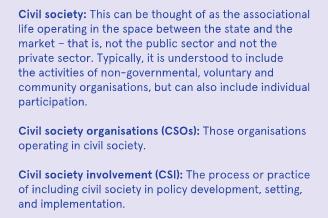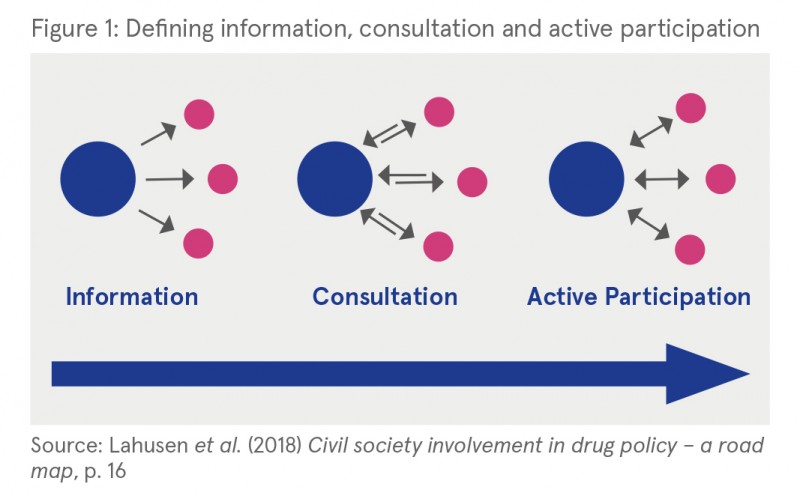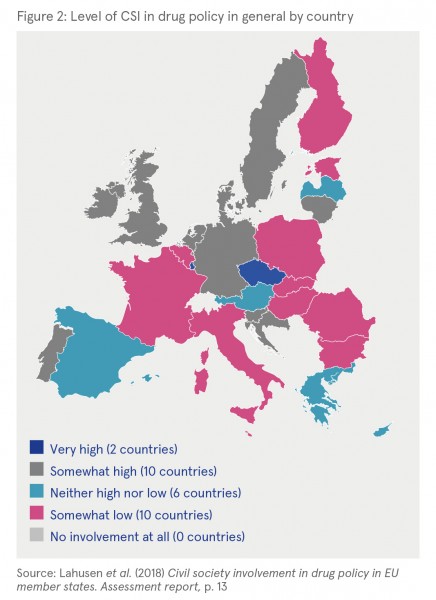Dillon, Lucy (2019) Civil society involvement in policymaking. Drugnet Ireland, Issue 69, Spring 2019, pp. 9-10.
| Preview | Title | Contact |
|---|---|---|
|
PDF (Drugnet Ireland 69)
1MB |
Civil society involvement (CSI) in the development and implementation of drug policy is widely considered best practice and promoted at both international and national levels. For example, a focus on the value of CSI is evident in both the EU drugs strategy 2013–20201 and the EU action plan on drugs 2017–2020.2 One of the 15 objectives of the latter is to ‘ensure the participation of civil society in drugs policy’. It is also a key part of Ireland’s national drugs strategy, Reducing harm, supporting recovery: a health-led response to drug and alcohol use in Ireland 2017–2025.3
In line with this strategic approach, the Civil Society Involvement in Drug Policy (CSIDP) project is supported by the European Commission under its European Civil Society Involvement Project.4 It comprises a group of organisations working in the field of CSI at national and European levels.5 It aims to support CSI in the development and implementation of drug policies at national and European levels. To do so, it has set out to provide stakeholders with guidance to stimulate and support effective CSI, as well as raise awareness on the relevance and importance of CSI at national and European levels. It has produced three outputs that should be of interest to both those in Ireland working in the area of drug policy and civil society organisations (CSOs):
- An assessment report of CSI in drug policy in EU member states 6
- A national action plan report on Ireland 7
- A road map for effective CSI in drug policy. 8
Benefits of CSI
It is useful to reiterate the internationally recognised benefits of a CSI approach to policy which are outlined in these reports. By engaging with CSOs, policymakers get an understanding of what is happening on the ground. They are then better placed to develop timely policies that are relevant to the ever-changing drug situation in their country. The exchange of information also encourages innovative thinking and new approaches to tackling problems, as well as an insight into the challenges and opportunities experienced by those working under existing policy structures. CSI can increase buy-in for a particular policy by both those who will be required to implement them and those at which they are aimed – ‘when civil society is involved, popular legitimacy increases’ (p. 7).8 It can lead to empowerment and increased participation among people who use drug services and hold policymakers accountable in ensuring that their civil and human rights are protected.
Assessment report and national action plan
The assessment report set out ‘to gain a better insight and create a better understanding of the nature and extent of civil society involvement in drug policy at the national level’ (p. 4).6 Across the member states, it looks at three elements: the extent to which civil society features in national drug strategy documents; the number of CSOs and the level of CSI in various areas of policy development and implementation; and an analysis of the barriers and facilitators to CSI.
European experience
The bulk of the report focuses on the second element. It is an account of responses to a detailed questionnaire aimed at making an assessment of CSI in national drug policy in general, and the development and implementation of each country’s drug strategy.9 It examines different levels of involvement (information, consultation, dialogue and partnership) (see Figure 1) across the different policy areas (prevention, treatment, harm reduction, law enforcement and legal framework). As could be expected, there was a lot of variation across the member states, making it challenging to draw comparisons and conclusions from the data. Despite this, three of the top-line findings, when considering the majority of the member states, were:
- Harm reduction represents the drug policy field with the highest level of CSI, and the fields of law enforcement and the legal framework are those with the lowest level.
- The level of CSI is generally higher during the implementation phase of policy than the development phase.
- There seems to be a lack of formal structures that support regular CSI in the development and implementation of drug policy.
Irish experience
Overall, the findings suggest that Ireland fares well in its experience of CSI. It does not appear to face the challenges that exist in some other member states. For example, the full range of levels of CSI in Ireland is reported to exist, from information to partnership, and it is seen as having a ‘somewhat high’ level of CSI in drug policy (see Figure 2). This positive picture of Ireland as an environment where there is CSI in drug policy is echoed in the National Action Plan (NAP) Report for Ireland.7,10 It notes that CSOs ‘have long been involved in the response to drugs and drug use in Ireland’ (p. 6)7 and found that there were good structures in place to facilitate CSI in drug policy – in particular those developed under the national drugs strategy, Reducing harm.
In general, it is fair to say that the new strategy has been positively received by civil society actors, that state structures are open and supportive of civil society participation, and that there has been a good amount of work focused on participation in the first year of the strategy’s implementation. (p. 13)7
However, it was also noted that there was a need to provide supports to ensure that these structures were used to their full effect in delivering CSI. Existing structures could be improved to increase direct participation and ownership by stakeholders and citizens, including people who use drugs (PWUD), members of the Travelling community and other minority communities, and young people. There was also a call to ensure that key decisions linked with the national drugs strategy are made within the relevant participative structures, and that there is CSI on any working groups established under the strategy.



Road map
The CSIDP’s road map is aimed at both policymakers and CSOs.8 Its main objective is ‘to provide guidance through the different steps of developing and implementing effective and sustainable civil society structures in the field of drug policy on the local, regional and national level, as informed by the best available evidence’ (p. 5). The road map is divided into three parts:
1 How to assess current levels of CSI in drug policy in a country.
2 What policymakers can do to enhance CSI – from implementing different mechanisms of CSI to funding CSOs and research.
3 What CSOs can do to enhance CSI – from addressing possible structural issues to planning advocacy activities.
The authors emphasise the need for input from both policymakers and CSOs if the CSI is to be meaningful. It is recognised that policymakers might be more hesitant about working in this way, so CSOs need to be proactive and be prepared to take a leading role in getting the process going. Essentially, the authors recommend two main things: an assessment of the existing level of CSI; and a structured approach to improving areas that are not working so well, with mutual agreement on actions that need to be carried out by policymakers and CSOs accordingly. The road map contains numerous toolkits and guidance sources for stakeholders to draw on. A detailed description of the guidance is beyond the scope of this article and it is recommended that those working in this field access the full report.
1 Council of the European Union (2012) The EU drugs strategy 2013–2020. Brussels: Council of the European Union. https://www.drugsandalcohol.ie/19034/
2 European Commission (2017) EU action plan on drugs 2017–2020. Brussels: Council of the European Union. https://www.drugsandalcohol.ie/27680/
3 Department of Health (2017) Reducing harm, supporting recovery: a health-led response to drug and alcohol use in Ireland 2017–2025. Dublin: Department of Health. https://www.drugsandalcohol.ie/27603/
4 For further information, visit: https://csidp.eu/
5 Ana Liffey Drug Project (ALDP) is a member of the group.
6 Lahusen H, Verthein U and Martens M-S (2018) Civil society involvement in drug policy in EU member states. Assessment report. Amsterdam: De Regenboog Groep/Correlation Network. https://www.drugsandalcohol.ie/29890/
7 Keane M, Crook L and Vieru C (2018) Ireland National Action Plan Report. Dublin: Ana Liffey Drug Project. https://www.drugsandalcohol.ie/30341/
8 Lahusen H, Keane M, Crook L, Košir M, Schiffer K, Ronconi S, et al. (2018) Civil society involvement in drug policy – a road map. Amsterdam: De Regenboog Groep/Correlation Network. https://www.drugsandalcohol.ie/29890/
9 The questionnaire was completed by representatives of one or more of the following bodies across the member states: a CSO, National Focal Point of the Reitox network, and administrative bodies with responsibility for drug policy. In Ireland, data were collected from a representative of the first two bodies.
10 An activity of the CSIDP was for five partner agencies to carry out a national action plan in their home countries: Bulgaria, Ireland, Italy, the Netherlands, and Portugal.
MA-ML Social science, culture and community > Sociocultural aspects of substance use > Societal attitude toward substance use / public opinion
MA-ML Social science, culture and community > Community action > Community involvement
MM-MO Crime and law > Legal rights > Civil / human rights
MP-MR Policy, planning, economics, work and social services > Policy > Policy on substance use
VA Geographic area > Europe > Ireland
Repository Staff Only: item control page